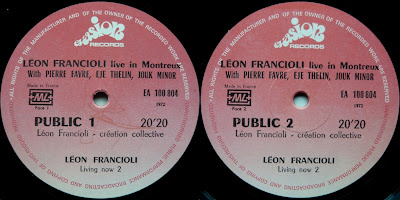Label: Arista – AL 1903, Freedom – AL 1903
Format: 2 × Vinyl, LP, Compilation / Country: US / Released: 1975
Style: Free Jazz, Free Improvisation
Recorded at Polydor Studios (Dames II), Paris, 26th June 1969.
Design [Sleeve] – Hamish Grimes
Photography By – Jan Persson
Engineer – J. P. Dupuy, P. Quef
Liner Notes – John B. Litweiler
Producer – Alan Bates, Chris Whent
Matrix / Runout (Side A runout, etched): AL 1903-SA
Matrix / Runout (Side B runout, etched): AL 1903-SB
Matrix / Runout (Side A runout, etched): AL 1903-SC
Matrix / Runout (Side B runout, etched): AL 1903-SD
At the second LP (side C) the first track misspelled: "Joro", and correctly is "Toro".
Tracklist:
A - Tutankhamun....................................................................................... 18:10
B1 - The Ninth Room .................................................................................. 15:35
B2- That The Evening The Sky Fell Through The Glass
Wall And We Stood Alone Somewhere?.............................................. 6:00
C1 - Toro .......................................................................................................8:25
C2 - Lori Song ............................................................................................... 3:53
C3- Tthinitthedalen Part One ....................................................................... 4:24
C4- Tthinitthedalen Part Two ....................................................................... 4:54
D - The Spiritual........................................................................................ 20:00
Roscoe Mitchell – alto sax / soprano sax / bass sax, clarinet, flute,
whistle, siren, bells, percussion
Lester Bowie – trumpet, flugelhorn, horns, drums [bass drum]
Joseph Jarman – alto sax / soprano sax / bass sax, clarinet, oboe, flute,
piano, harpsichord, guitar, percussion
Malachi Favors – bass, bass [Fender], banjo, sitar, percussion
The Art Ensemble of Chicago is an avant-garde jazz group that grew out of the Association for the Advancement of Creative Musicians (AACM) in the late 1960s. The ensemble integrates many jazz styles and plays many instruments, including "little instruments": bells, bicycle horns, birthday party noisemakers, wind chimes, and various forms of percussion. The musicians wear costumes and face paint while performing. These characteristics combine to make the ensemble's performances both aural and visual. While playing in Europe in 1969, five hundred instruments were used.
![]()
![]()
![]()
![]()
Members of what was to become the Art Ensemble performed together under various band names in the mid-sixties, releasing their first album, Sound, as the Roscoe Mitchell Sextet in 1966. The Sextet included saxophonist Roscoe Mitchell, trumpeter Lester Bowie, and bassist Malachi Favors. For the next year, they played as the Roscoe Mitchell Art Ensemble. In 1967, they were joined by fellow AACM members Joseph Jarman (saxophone) and Phillip Wilson (drums) and recorded for Nessa Records.
All of the musicians were multi-instrumentalists. Jarman and Mitchell's primary instruments were alto and tenor saxophone, respectively, but they played other saxophones (from the small sopranino to the large bass saxophone), and the flute and clarinet. In addition to trumpet, Bowie played flugelhorn, cornet, shofar, and conch shells. Favors added touches of banjo and bass guitar. Most of them dabbled in piano, synthesizer, and other keyboards.
In 1969, Wilson left the group to join Paul Butterfield's band. The remaining group travelled to Paris, where they became known as the Art Ensemble of Chicago. The impetus for the name change came from a French promoter who added "of Chicago" to their name for descriptive purposes, but the new name stuck because band members felt that it better reflected the cooperative nature of the group. In Paris, the ensemble was based at the Théâtre des Vieux Colombier and they recorded for the Freedom and BYG labels. They also recorded Comme à la radio with Brigitte Fontaine and Areski Belkacem but without a drummer until percussionist Don Moye became a member of the group in 1970.
The double album "The Paris Session" is a compilation of studio recordings from this period in Paris 1969 which were originally realized in two vinyl editions "Tutankhamun" and "The Spiritual" (both Freedom Records), plus material that was first released on this LP.
If you find it, buy this album!




































































































































